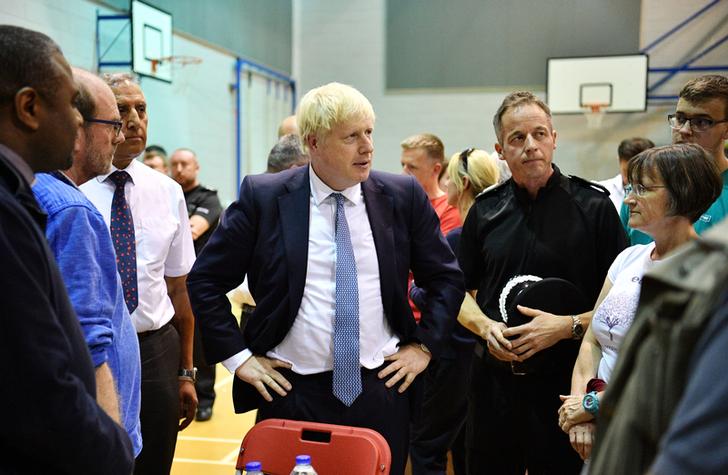LONDON - Whatever happened in the encounter last week between UK PM Boris Johnson’s chief European envoy and EU officials, it was no meeting of m
LONDON – Whatever happened in the encounter last week between UK PM Boris Johnson’s chief European envoy and EU officials, it was no meeting of minds.
Bear in mind that it was only a few weeks ago that Johnson described the chances of no-deal as “a million to one”, and that the official UK government line remains to want to negotiate in good faith.
Since then, the rhetorical tactic has clearly shifted to a) talking up the prospects of no deal and b) blaming such any such outcome on EU intransigence.
Forecasters agree that the worst-hit countries in the event of no deal would be Britain followed by Ireland.
A glimpse of that came through in today’s PMI services read-out for Ireland, which showed the first fall in new exports since 2016.
While the headline figure remains at 55.0 – still well above the 50 mark that separates growth from contraction – the sub-index for new export orders fell to 49.4 from 53.4, the first shrinkage November 2016.
The authors cited a decrease in orders from the United Kingdom owing to Brexit uncertainty as a factor.
Germany’s industrial orders data for June this morning are a double-edged sword.
On the one hand, there will be relief that they rose an above-forecast 2.5 percent.
On the other, that figure is buoyed mainly by orders from non-euro zone countries, while demand from within the single currency zone dropped for the third month in a row.
That suggests Germany’s main problem is not a global slowdown but weakness closer to home – something the European Central Bank will no doubt factor into its next policy moves.
MARKETS AT 0755 GMT
Tit for tat, indeed.
Beijing’s response on Monday was to let the yuan slide through 7 per dollar to its lowest in 11 years.
The U.S. Treasury then responded late Monday by formally designating China as a “currency manipulator” and adding it would seek arbitration at the International Monetary Fund over unfair trade practises.
The inevitable extension of this exchange is that Trump also makes good on his threat that the 10% tariffs rise to 25%.
And markets are inevitably spooked, with Wall St and global equity indices having their worst day of the year on Monday and the losses have deepened early Tuesday as volatility gauges surge.
The U.S. Treasury’s move on “currency manipulation” is in large part just symbolic. Technically, it gives it cover for retaliating on trade when in practice it has already been jacking up tariffs on China for the past year.
What’s more, critics say the criticism of “currency manipulation” for trade advantage rings a bit hollow as any significant intervention conducted by the Chinese over the past three years has likely been to hold the yuan up rather than artificially weakening it.
Nevertheless, the whole episode is showing investors just how quickly these trade rows can get out of hand and how much damage they can do to an already fragile world economy.
And there’s a fear that weaponising long-dormant major exchange rates for trade purposes risks uncorking global markets volatility at an edgy time.
The dash to traditional safe assets has been rapid.
The S&P500 had its worst day of the year on Monday, losing almost 3%, and the rebound in the futures today has been modest at just 0.25% so far.
The index is now down more than 6% from last month’s record high.
The surge in the Vix “fear gauge” to more than 24% brought it to highest since Jan. 4.
The selling continued through Asia markets overnight, with Shanghai stocks down almost 2% to their lowest since February, Hong Kong’s Hang Seng is down more than 1%, South Korea’s Kospi down 1.5% and Japan’s Nikkei down 0.7%.
Compounding the trade war fears have been a series of worrying geopolitical developments, with increasingly violent street protests in Hong Kong drawing angry insistence about Chinese unity from Beijing, India dramatically removing Kashmir’s special status on Monday and North Korea firing another two short-range missiles into Sea of Japan on Tuesday.
The bid to safety from trade, recession and political fears has seen a huge additional bid for top-rated government bonds – with 10-year U.S. Treasury yields falling to as low as 1.6770%, their lowest since before Trump came to power in 2016.
The recession flag in the U.S. Treasury yield curve continued to wave furiously as the curve between 3 months and 10-years inverted further to its most negative since 2007 at more than 30 basis points despite the Fed’s easing last week and rising expectations of a cut of up to 50 basis points at next month’s meeting.
European sovereign debt yields continued to sink sub-zero, with Irish 10-year government bonds the latest to go negative on Monday along with 30-year Dutch government debt.
On the economic front, the irony has been that latest incoming data has been upbeat – albeit now trumped by the deterioration of the trade situation since last week.
Global all-industry business surveys came in ahead of forecasts for July and German industrial orders numbers for June also beat forecasts early on Tuesday.
Markets, however, will tend to view this as ancient history against the backdrop of what’s happened over the past week.
MSCI’s emerging markets currency index fell to its lowest level of the year earlier before finding its feet.
The dollar’s DXY index firmed after touching a two-week low.
Amid talk and speculation of China shifting bond investments to Europe from the United States, euro/dollar has been firm this week – recapturing 1.12 and holding just there this morning.
In European corporate news, there are some more earnings updates to digest, especially from corporate Germany, with the overall picture looking mixed.
Fresh deal-making activity will also keep investors busy.
Shares in Deutsche Post are up 2% in early trade after the group said it sees a further improvement in earnings in H2 due to restructuring measures and a rise in German postage prices despite a tough economic environment. Shares in Beiersdorf are down 2.6% in early trade after the German consumer goods firm reported slowing sales growth for its Nivea skin care brand in Q2, although it confirmed its outlook for 2019.
Encourging comments on the start of the quarter are pushing Heidelberger Druck up more than 5% in early trade, while shares in Gea, Norma and Pfeiffer Vacum were all seen falling after results.
In the aerodefence sector, shares in both engineering firm Meggitt and engine maker Rolls Royce are seen opening 2% higher after results.
uk.reuters.com


